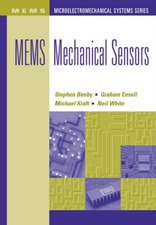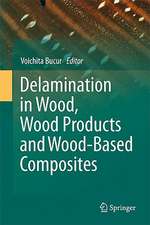Fire Behavior and Fire Protection in Timber Buildings: Springer Series in Wood Science
Autor Roza Aseeva, Boris Serkov, Andrey Sivenkoven Limba Engleză Hardback – 18 dec 2013
| Toate formatele și edițiile | Preț | Express |
|---|---|---|
| Paperback (1) | 944.82 lei 6-8 săpt. | |
| SPRINGER NETHERLANDS – 23 aug 2016 | 944.82 lei 6-8 săpt. | |
| Hardback (1) | 950.84 lei 6-8 săpt. | |
| SPRINGER NETHERLANDS – 18 dec 2013 | 950.84 lei 6-8 săpt. |
Din seria Springer Series in Wood Science
- 18%
 Preț: 1543.84 lei
Preț: 1543.84 lei - 23%
 Preț: 2062.76 lei
Preț: 2062.76 lei - 18%
 Preț: 1824.32 lei
Preț: 1824.32 lei - 24%
 Preț: 817.72 lei
Preț: 817.72 lei - 18%
 Preț: 1225.16 lei
Preț: 1225.16 lei - 18%
 Preț: 3288.92 lei
Preț: 3288.92 lei - 18%
 Preț: 948.29 lei
Preț: 948.29 lei - 18%
 Preț: 1222.31 lei
Preț: 1222.31 lei - 18%
 Preț: 2093.60 lei
Preț: 2093.60 lei - 18%
 Preț: 946.87 lei
Preț: 946.87 lei - 15%
 Preț: 643.34 lei
Preț: 643.34 lei - 18%
 Preț: 1122.87 lei
Preț: 1122.87 lei - 18%
 Preț: 1020.30 lei
Preț: 1020.30 lei - 24%
 Preț: 836.42 lei
Preț: 836.42 lei - 20%
 Preț: 569.49 lei
Preț: 569.49 lei - 15%
 Preț: 638.89 lei
Preț: 638.89 lei - 15%
 Preț: 636.30 lei
Preț: 636.30 lei - 15%
 Preț: 635.31 lei
Preț: 635.31 lei - 18%
 Preț: 878.05 lei
Preț: 878.05 lei - 15%
 Preț: 646.43 lei
Preț: 646.43 lei - 18%
 Preț: 1004.67 lei
Preț: 1004.67 lei - 18%
 Preț: 894.03 lei
Preț: 894.03 lei - 15%
 Preț: 658.70 lei
Preț: 658.70 lei - 15%
 Preț: 641.53 lei
Preț: 641.53 lei - 18%
 Preț: 783.35 lei
Preț: 783.35 lei - 15%
 Preț: 645.79 lei
Preț: 645.79 lei - 24%
 Preț: 880.81 lei
Preț: 880.81 lei -
 Preț: 388.13 lei
Preț: 388.13 lei - 18%
 Preț: 780.82 lei
Preț: 780.82 lei - 15%
 Preț: 529.13 lei
Preț: 529.13 lei
Preț: 950.84 lei
Preț vechi: 1159.56 lei
-18% Nou
Puncte Express: 1426
Preț estimativ în valută:
182.00€ • 197.76$ • 152.98£
182.00€ • 197.76$ • 152.98£
Carte tipărită la comandă
Livrare economică 21 aprilie-05 mai
Preluare comenzi: 021 569.72.76
Specificații
ISBN-13: 9789400774599
ISBN-10: 9400774591
Pagini: 300
Ilustrații: IX, 290 p. 85 illus.
Dimensiuni: 155 x 235 x 22 mm
Greutate: 0.6 kg
Ediția:2014
Editura: SPRINGER NETHERLANDS
Colecția Springer
Seria Springer Series in Wood Science
Locul publicării:Dordrecht, Netherlands
ISBN-10: 9400774591
Pagini: 300
Ilustrații: IX, 290 p. 85 illus.
Dimensiuni: 155 x 235 x 22 mm
Greutate: 0.6 kg
Ediția:2014
Editura: SPRINGER NETHERLANDS
Colecția Springer
Seria Springer Series in Wood Science
Locul publicării:Dordrecht, Netherlands
Public țintă
ResearchCuprins
Introduction.- Part 1 Behavior of timber at high temperature heating and fire- Chapter 1: Specificity of structure and properties of different timber species.- 1.1. Macro- and microstructure of deciduous and coniferous timber species.- 1.2 Biological and genetic aspects of timber species diversity.- 1.3 Density and moisture of timber species.- 1.4 Thermal and physical properties of timber species.- 1.5 Effect of heating on mechanical properties of timber.- Chapter 2: Pyrolisis and oxidative decomposition of timber.- 2.1 Mechanism and macrokinetics of pyrolisis of timer.- 2.2 Decomposition of different timber species at thermal oxidation.- 2.3 Numerical models for decomposition and charring of timber.- Chapter 3: The ignition of timber.- 3.1 Smoldering and glowing ignition of timber.- 3.2 Spontaneous flaming ignition of different timber species.- 3.3 Piloted ignition of timber from radiant heater.- Chapter 4: Heat release characteristics and combustion heat of timber.- 4.1 Chemical composition and lowest heat of complete combustion of different timber species.- 4.2 Effect of fire conditions on heat release characteristics oftimber.- Chapter 5: Flame propagation on timber surface.- 5.1 Model approaches for flame propagation on carbonizing timber materials.- 5.2 Flame propagation on timber surface towards to direction of oxidizer flow.- 5.3 Flame propagation on timber surface at passing direction of oxidizer flow.- Chapter 6: Generation of smoke and toxic products at fire of timber.- 6.1 Characteristics of smoking ability of different timber species.- 6.2 Effect of timber combustion regime on toxicity of forming volatile products.- Part 2: Fire safety and fire protection of timber buildings.- Chapter 7: Fire safety and fire resistance of timber building structures and constructions.- 7.1 General approaches to the system of fire safety in timber buildings and thermal fire regime’s assessment.- 7.2 Dynamics of change of fire hazard factors during fire growth and decay phase.- 7.3 Charring rate of different timber species and glued laminated timber at nominal fire exposure.- 7.4 Structure and thermo-physical properties of formed superficial char layers.- 7.5 Fire resistance of timber building members and charring depth.- Chapter 8: Fire protection of timber building structures and constructions
8.1Recent ways and means of fire protection to increase fire safety and fire resistance of timber building structures.- 8.2 Novel fire retardant impregnation compositions for treatment of timber.- 8.2.1 Effect of surface and deep of fire retardant impregnation of timber on fire safety characteristics.- 8.2.2 Charring parameters of different timber species with fire retardant treatment at standard fire regime.- 8.3 Fire protecting properties of novel environmental friendly intumescent coatings for timber based on plant raw material.- 8.3.1 Method of oxidative modification of plant raw material and some physicochemical characteristics of products.- 8.3.2 Effect of modification and type of plant raw material on fire protection efficiency of intumescent coatings.- Part 3: Effect of natural and accelerated artificial aging on fire behavior of timber buildings.- Chapter 9: Effect of natural aging of timber building structures on fire behavior and fire safety.- 9.1 Transformations in physical structure, chemical composition and properties in old and ancient timber buildings.- 9.2 Effect of natural age duration on some fire safety characteristics of members of old and ancient timber buildings.- 9.3 Charring parameters and physical properties of char formed at fire action on old timber building structures.- 9.4 Biodegradation of solid timber and complex biological, moisture and fire protection of timber buildings.-Chapter 10: The changes in fire behavior timber based on different of wood species after accelerated artificial aging.- 10.1 Methods of accelerated artificial aging of timber.- 10.2 Results of physicochemical and thermal analysis of aged timber.- 10.3 Fire safety indices of artificial aged timber based on different wood species.- Conclusions.- Subject index.- Authors’ resumes.
8.1Recent ways and means of fire protection to increase fire safety and fire resistance of timber building structures.- 8.2 Novel fire retardant impregnation compositions for treatment of timber.- 8.2.1 Effect of surface and deep of fire retardant impregnation of timber on fire safety characteristics.- 8.2.2 Charring parameters of different timber species with fire retardant treatment at standard fire regime.- 8.3 Fire protecting properties of novel environmental friendly intumescent coatings for timber based on plant raw material.- 8.3.1 Method of oxidative modification of plant raw material and some physicochemical characteristics of products.- 8.3.2 Effect of modification and type of plant raw material on fire protection efficiency of intumescent coatings.- Part 3: Effect of natural and accelerated artificial aging on fire behavior of timber buildings.- Chapter 9: Effect of natural aging of timber building structures on fire behavior and fire safety.- 9.1 Transformations in physical structure, chemical composition and properties in old and ancient timber buildings.- 9.2 Effect of natural age duration on some fire safety characteristics of members of old and ancient timber buildings.- 9.3 Charring parameters and physical properties of char formed at fire action on old timber building structures.- 9.4 Biodegradation of solid timber and complex biological, moisture and fire protection of timber buildings.-Chapter 10: The changes in fire behavior timber based on different of wood species after accelerated artificial aging.- 10.1 Methods of accelerated artificial aging of timber.- 10.2 Results of physicochemical and thermal analysis of aged timber.- 10.3 Fire safety indices of artificial aged timber based on different wood species.- Conclusions.- Subject index.- Authors’ resumes.
Textul de pe ultima copertă
This volume describes the modern data on fire behavior and fire protection of timber in outdoors and indoors application mainly in construction industry. The book discusses the most important topics of that area of science and engineering such as: Specificity of structure and properties of different timber species; Pyrolisis and oxidative decomposition of timber; The ignition of timber; Heat release characteristics and combustion heat of timber; Flame propagation on timber surface; Generation of smoke and toxic products at fire of timber surface; Generation of smoke and toxic products at fire of timber; Fire safety and fire resistance of timber building structures and constructions; Fire protection of timber building structures and constructions; Effect of natural aging of timber building structures on fire behavior and fire safety; The changes in fire behavior timber based on different of wood species after accelerated artificial aging.
The Authors’ novel approach discovered the relationship between various species and age of timbers and its fire behavior at different thermal and fire loads. Quantitative data on ignition speed and flame propagation and generation of heat, smoke and toxic products are discussed for most types of timbers applicable in engineering practice. Analysis of fire resistance of various types of timber building materials and very new data on the effect of natural and accelerated aging of timber fire behavior are discussed. The main practical methods of fire protection of new and ancient timber structures using novel coatings (without regular fire retardants) are considered.
Most of the data contained in the book are based on the authors’ research and practical experienceaccumulated during many years of their activity in the area. The book should be useful for a wide range of readers: chemists, physicists, material scientists, architects, engineers, constructors and restorers involved in study and practice of fire behavior and fire protection of timber.
The Authors’ novel approach discovered the relationship between various species and age of timbers and its fire behavior at different thermal and fire loads. Quantitative data on ignition speed and flame propagation and generation of heat, smoke and toxic products are discussed for most types of timbers applicable in engineering practice. Analysis of fire resistance of various types of timber building materials and very new data on the effect of natural and accelerated aging of timber fire behavior are discussed. The main practical methods of fire protection of new and ancient timber structures using novel coatings (without regular fire retardants) are considered.
Most of the data contained in the book are based on the authors’ research and practical experienceaccumulated during many years of their activity in the area. The book should be useful for a wide range of readers: chemists, physicists, material scientists, architects, engineers, constructors and restorers involved in study and practice of fire behavior and fire protection of timber.
Caracteristici
Natural wood is considered as a natural composite material and it fire behavior and fire resistance depends simultaneously both on physical structure (morphology) and specificity of chemical structure of various wood species and age .The main experimental data on fire behavior and engineering recommendations on fire resistance of building constructions summarize the authors’ results developed at State Fire Academy, Moscow, Russia Another unique point on the book is its practical content, one of the most important practical developments of authors’ approach is ability to predict the behavior and longevity of real building structures and constructions at fire For the first time data has been presented on how the age of natural wood of various species (both very old and fresh wood) affects fire behavior The very novel industrial technology has been developed to considerably improve fire safety of building constructions based on natural wood using the intumescing (self-foaming) organic coatings which do not contain common fire retardant elements Wide range of readers and users: students, researchers, engineers, constructors, architects and restorers The book is divided on purpose in three parts and each group of readers can find useful information according to their specific interests In many aspects the proposed book can be characterized as a short but condensed encyclopedia on fire behavior and fire resistant of natural wood




